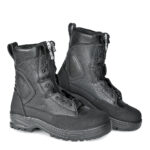Take 7 Steps to Select Appropriate Slip-Resistant Footwear for Workers

Workers’ feet are vulnerable to many types of injuries on the job. For example, they can be crushed, punctured or doused with hazardous substances. In addition, wearing appropriate footwear is critical to prevent workers from slipping and falling.
But choosing safety footwear that has adequate slip resistance isn’t easy, especially when work surfaces can’t be controlled, such as outdoors. To make an informed choice, you must consider a number of factors related to the worker, the environment and the tasks to be accomplished.
The IRSST recently released an information pamphlet that spells out the steps to take to select footwear that provides good grip as well as adequate protection against other hazards. These steps are:
Step #1: Form a committee. Create a selection committee that includes workers familiar with the work environment and the tasks performed, which ensures that the choice of footwear will be well adapted to needs and, ultimately, will increase the chances that the footwear selected will actually be worn.
Step #2: Consider all relevant factors. Analyze the characteristics of the work environment (indoors and outdoors), the tasks to be performed, the types of surface and contaminants on which the workers may have to move around (oil, grease, water, dust, etc.), and the hazards to which they’re exposed.
Also, take into account protection duties related to the tasks performed for the following hazards:
- Sharp or pointed objects, penetration of foreign bodies
- Dropped objects or blows to the feet
- Explosive atmospheres where there’s a risk of electrostatic discharge
- Contact with low- or medium-voltage electrical conductors
- Exposure to corrosive or irritating substances.
And consider every aspect that could influence the choice of footwear:
- Comfort: heat/cold, impermeability and sufficient size range (width and length) to suit all the workers
- Overall cost: takes into account quality and durability, which, in the long term, can reduce the cost of incidents or the frequency of replacement (Learn about who should pay for PPE, including safety footwear.)
- Ergonomics: ankle support, if necessary, design compatible with work (for example, adapted for stairs or ladders or for using shoe covers), easy upkeep, etc.
- Esthetic: visual appeal.
Step #3: Choose an adequate sole. Inform the supplier of the characteristics of your work environment (ground, contaminants, temperature’). But don’t make your choice based solely on the information provided by advertising brochures, because a shoe marketed as being anti-slip may not fit your specific situation. For example, a shoe that grips well on a wet surface may not be suited to an oily surface.
Consider the parts of the sole that could have an influence on its ability to grip, including:
- The materials;
- The rigidity (hard or soft sole) according to the ambient temperature;
- The durability;
- The support surface (surface in contact with the ground);
- The shape of the heel and the sole; and
- The tread design and pattern (groove depth, width, spacing, etc.).
Step #4: Validate the choice before buying. Select a variety of models with different soles. Ensure that all these models are adapted to the environment and tasks to be performed, and that they can satisfy workers in terms of both comfort and look.
Obtain a few pairs of the models chosen from suppliers and try them out with workers under real working conditions. Select a representative sample of workers at risk and have them try each model for a long enough time in the workplace. Ensure that they wear the footwear properly. Gather their feedback on the shoes. Note if there were any incidents of slipping, tripping or falling during the tests.
Step #5: Buy the most suitable footwear. Take into account that a single model may not be right for all workers. Sometimes, it’s better to have more than one model, which gives workers the opportunity to choose the one they find the most comfortable and for the organization to satisfy the greatest number of workers possible.
Step #6: Assess satisfaction and ensure upkeep after purchase. Verify that the footwear is actually being worn by the workers. If not, determine why they’re not wearing it. Periodically assess the level of satisfaction among workers: is the footwear still performing and responding to their needs’ Ensure that the footwear is properly maintained and that it’s replaced when worn out.
Step #7: Ensure the choice remains appropriate. Note any incident of slipping, tripping or falling. If such an event occurs, note the model of footwear worn, its condition (worn, dirty, etc.) and the nature of the surface at the time of the event. Repeat certain steps in the process if the footwear is found not to be suitable, or no longer suitable because of changes in the environment or the tasks performed.
The OHS Insider has articles, tools and other resources on safety footwear, including:
- Safety footwear requirements under the OHS laws
- Spot the Safety Violation: Protect Your Feet with Appropriate Footwear.
[box]
Want access to all the Canadian safety compliance resources that the OHS Insider has to offer, such as the articles listed above, and much more’ Sign up for a free trial membership now! [/box]